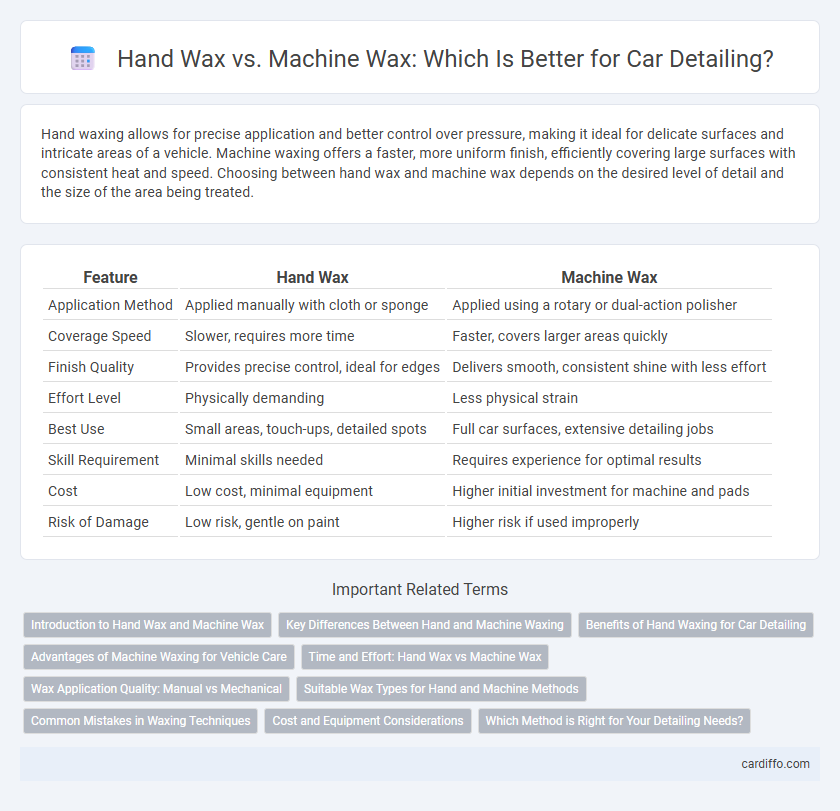Hand waxing allows for precise application and better control over pressure, making it ideal for delicate surfaces and intricate areas of a vehicle. Machine waxing offers a faster, more uniform finish, efficiently covering large surfaces with consistent heat and speed. Choosing between hand wax and machine wax depends on the desired level of detail and the size of the area being treated.
Table of Comparison
| Feature | Hand Wax | Machine Wax |
|---|---|---|
| Application Method | Applied manually with cloth or sponge | Applied using a rotary or dual-action polisher |
| Coverage Speed | Slower, requires more time | Faster, covers larger areas quickly |
| Finish Quality | Provides precise control, ideal for edges | Delivers smooth, consistent shine with less effort |
| Effort Level | Physically demanding | Less physical strain |
| Best Use | Small areas, touch-ups, detailed spots | Full car surfaces, extensive detailing jobs |
| Skill Requirement | Minimal skills needed | Requires experience for optimal results |
| Cost | Low cost, minimal equipment | Higher initial investment for machine and pads |
| Risk of Damage | Low risk, gentle on paint | Higher risk if used improperly |
Introduction to Hand Wax and Machine Wax
Hand wax involves applying wax manually using soft applicator pads, allowing precise control and careful attention to smaller or intricate surfaces. Machine wax utilizes a powered buffer or polisher to evenly distribute wax, providing a faster application ideal for larger vehicle areas. Both methods enhance paint protection and shine but differ in effort, speed, and finish quality.
Key Differences Between Hand and Machine Waxing
Hand waxing offers precise control and is ideal for delicate areas, allowing for a detailed finish with minimal risk of damage, while machine waxing provides faster application suitable for larger surfaces but may lack the nuanced touch of manual techniques. Machine waxers generate consistent heat and pressure, ensuring even coverage and durability, whereas hand waxing allows for customized pressure and focus in hard-to-reach spots. The choice between hand and machine wax depends on the vehicle's surface complexity, time constraints, and desired finish quality.
Benefits of Hand Waxing for Car Detailing
Hand waxing offers precise control, allowing detailers to target specific areas and achieve a deeper, more thorough application for enhanced paint protection and a richer gloss. It minimizes the risk of swirl marks or paint damage often caused by machine waxers, preserving the vehicle's finish. The tactile feedback during hand waxing ensures better coverage and enables the removal of minor imperfections, resulting in a superior, long-lasting shine.
Advantages of Machine Waxing for Vehicle Care
Machine waxing offers a more consistent and even application of wax, enhancing the vehicle's shine and providing superior protection against environmental elements. It significantly reduces the time and physical effort required compared to hand waxing, making it ideal for larger vehicles or frequent detailing. The increased efficiency and uniform coverage achieved with machine waxing help maintain the vehicle's paint quality over a longer period.
Time and Effort: Hand Wax vs Machine Wax
Hand wax requires significantly more time and physical effort, involving meticulous application and buffing by hand, which can be labor-intensive and slow, especially for larger vehicles. Machine wax employs power tools like dual-action polishers that accelerate the process, reducing overall time while delivering consistent, even coverage with less fatigue. For professional detailing, machine waxing boosts efficiency, but hand waxing allows precision in hard-to-reach areas, balancing effort and detail quality.
Wax Application Quality: Manual vs Mechanical
Hand wax application delivers superior control and precision, allowing detailers to reach intricate surfaces and ensure an even, thorough coating that enhances paint protection and shine. Machine wax application provides consistent pressure and speed, promoting faster coverage but may risk uneven layering or missed spots on curves and edges. Optimal wax application quality balances the meticulous care of manual waxing with the efficiency of mechanical tools to achieve flawless, long-lasting results.
Suitable Wax Types for Hand and Machine Methods
Hand wax typically uses softer, more pliable waxes such as carnauba or paste wax, which allow for precise application and better control over coverage on small surfaces. Machine waxes are often formulated with synthetic polymers and harder wax blends designed to withstand the high-speed rotation of buffing machines, providing a smoother, more durable finish on large areas. Selecting the right wax type for hand or machine application ensures optimal protection, gloss, and longevity of the vehicle's paintwork.
Common Mistakes in Waxing Techniques
Hand waxing often results in uneven layers and missed spots due to inconsistent pressure application, while machine waxing can cause overheating and swirl marks if not handled properly. Common mistakes include using too much wax, leading to residue buildup, and not allowing the wax to cure fully before buffing, which diminishes the shine and protection. Proper technique and equipment calibration are essential to maximize the durability and gloss of both hand and machine-applied wax.
Cost and Equipment Considerations
Hand wax requires minimal equipment, making it a cost-effective choice for small-scale or occasional detailing. Machine wax involves investing in a power buffer, which increases upfront costs but delivers faster, more consistent application. Considering long-term efficiency and budget constraints helps determine the best waxing method for vehicle detailing.
Which Method is Right for Your Detailing Needs?
Hand waxing offers precise control and thorough coverage, making it ideal for intricate detailing and delicate surfaces. Machine waxing provides faster application and consistent results, suitable for larger vehicles and time efficiency. Choosing between hand wax and machine wax depends on your vehicle's condition, desired finish, and available time for the detailing process.
Hand Wax vs Machine Wax Infographic

 cardiffo.com
cardiffo.com